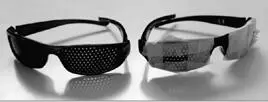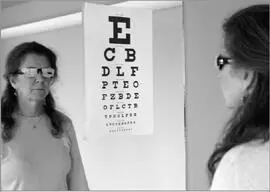Tony reduced his myopia and reduced the floaters, and his vision is perfect now compared to how it used to be; it is better without his glasses, and it’s better with his glasses, and with much less correction. (This wonderful man volunteered to have his picture taken as the model on my DVD, Yoga for Your Eyes , which has helped many people to see better.)
Tony used the internal forces of his own body to improve his eyes, and the improvement was massive. You can do the same. Your internal forces are only partially known, and they’re stronger than what anyone can imagine.
Even though many floaters are not a result of vitreous detachment, the treatment is the same. You have to mentally accept the fact that it’s okay for you to have this floater; then you have to look at it. If you’ve lived with floaters for many years and it’s familiar to you, it will probably be hard for your mind to believe they can disappear. If it is one floater, look at it. If there are groups of floaters, look only at one group. If it is a big floater, look at one part of it. Repeated exercises will show you that you can actually decrease it, change its shape and, with time, rid yourself of it. The only thing that keeps the floater going is your disgust for that floater and lack of willingness to look at it. That’s what happens with most people. We have forces within us that can destroy that which impedes us, if we only let them do it.
Additionally, what we learn from the fact that we are experiencing vitreous detachment in the first place is that the health of the eye is going in the wrong direction. Therefore, once we eliminate the floaters, we must return to the basic eye exercises in the beginning of this book in order to strengthen and heal the entire eye.
Correcting Macular Puckers and Holes
Some people suddenly discover they can no longer see centrally. It’s a scary situation. From such a person’s viewpoint, one day he or she sees perfectly, and the next day his or her central vision has disappeared. When the person meets an ophthalmologist, the ophthalmologist has absolutely nothing to offer except sympathy.
Often, this situation is caused by macular holes and macular puckers—basically, detachment of the vitreous that takes with it a part of the macula. Other times, we simply have cells that have withered and died. In all cases, the treatment is the same.
Exercise Program for Macular Puckers and Holes:
80 Minutes a Day
• Palming: 24 minutes daily, 6 minutes at a time.
• Sunning: 30 minutes daily, in three 10-minute intervals.
• Skying (if there is no sun): 8 minutes daily.
• Long Swing: 5 minutes daily.
• Pinhole Glasses: 10 minutes daily.
Remember not to simply take one part of the day and do your eye exercises all at once. The best results come from working on your eyes all the time, throughout your day. Find a few minutes here and there and let the eye exercises in this book find their way naturally into your routine. Thus, vision improvement will become part of your daily life in an organic way. This is the way to improve for the long term.

Figure 6.13. Pinhole glasses and pinhole glasses with obstruction.
Extra Exercise for Macular Puckers and Holes: Pinhole Glasses
Put the pinhole glasses on and then cover the eye that sees normally. Use the eye that has the macular hole in it to look straight ahead at an eye chart. You should put the eye chart in full light, preferably sunlight. The pinhole glasses will protect you from the temporary glare, and your tendency will be to tilt your head to see. Don’t tilt your head; instead, look straight ahead. Then close your eyes and remember exactly how the letters looked to you.
At times, you will see only the very big letter from a very short distance. If that’s what you see, it’s okay. Allow that area of your eye to be functional. After you remember the exact shape and contour of the letter or letters that you saw, open your eyes and look again.
Now move your head very slightly from side to side, no more than half a centimeter. That’s enough for you to see the letter moving in the opposite direction from the way you are moving, through the fuzz or the veil that you are looking through.
The next step is to put masking tape on the pinhole lens covering the area that would be the central periphery, and do the same exercise.

Figure 6.14. Use the eye that has the macular hole in it to look straight ahead at an eye chart.
Normally, when you have a macular pucker, you see better peripherally. So next, cover the entire lens over the weaker eye with construction paper that has only a tiny hole, made by a pen or pencil, right where the main blind spot is in your vision. Now look at the eye chart through that pinhole you made.
Note: It is dangerous to create a hole in the paper while you are wearing these glasses. Do not create the hole while the paper is on your face. Even though it seems easiest to do it this way (since only then can you test whether the hole is in the correct spot), it is best to find the blind spot and to create the hole on the paper when it is away from your eyes. It may take you a few tries until the hole is positioned right in front of the fuzzy or blind spot, but do not do it in front of your face, even if it seems more convenient to do so.
Sometimes it’s impossible to see any print through the hole. If that is the case with your vision, you should start this exercise by stimulating that area with blinking lights like the ones you can order through our School for Self-Healing in San Francisco.
With a macular pucker, some cells are still alive, but they are dormant in most cases, and they’re not being activated. Looking at the eye chart with only the fuzzy area in your central field will clarify your vision. Even slight clarification can make a big difference to your visual system because it eases the burden on the rest of the cells.
Correcting Retinitis Pigmentosa
Note: If you have turned to this section because you have retinitis pigmentosa, you should not read on without a broader understanding of our approach. Please go back to the beginning of the book and work from there onward. Be aware of all the deep concepts of life, vitality, and vision. Then you will be ready to work with this section.
Retinitis pigmentosa is an inherited disease characterized by a gradual, progressive degeneration of the retina. This leads to loss of peripheral vision and night vision difficulties and can also lead to central vision loss as well.
If you know that you are predisposed to retinitis pigmentosa, you should start to work on shifting and peripheral vision exercises at a very young age. If you did this, you would simply be diagnosed as having some missing spots in your visual system, but you would basically see well.
Although retinitis pigmentosa is genetic in nature, it is exacerbated by the normal stresses in life. What are our stresses? It is stressful when you look at someone and can see only their head and not the rest of them. It is even more stressful to see everything fuzzy. Another major source of stress is caused by the vision loss itself. It is especially stressful when you see well enough to get by, but not well enough to function fully. You may walk on the street and see people, but you don’t recognize your friend’s face immediately. Mental stress occurs from people having their feelings hurt by that, and from you criticizing yourself about it, even though you would forgive anyone else for not being able to see someone’s face.
Читать дальше













